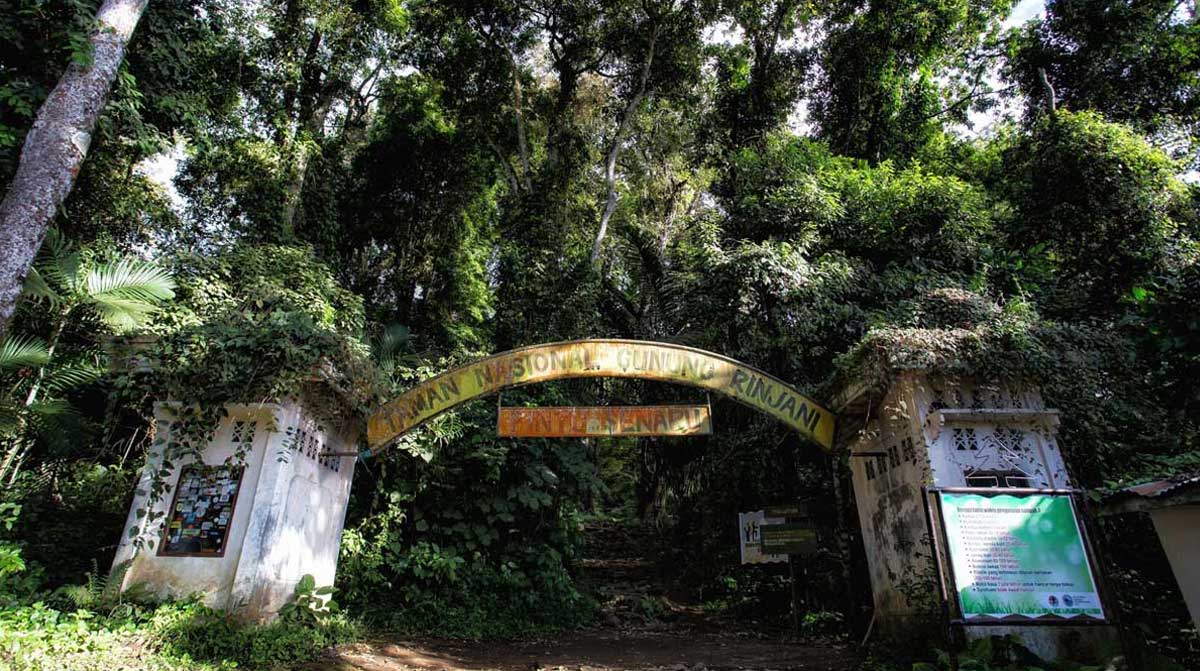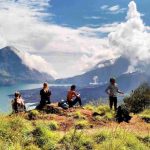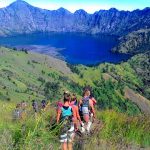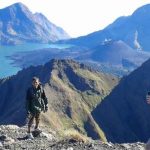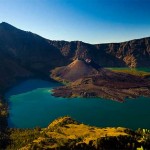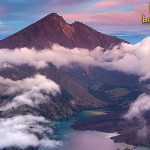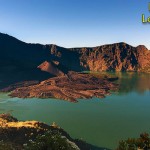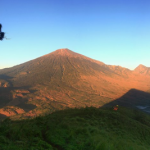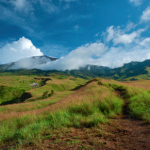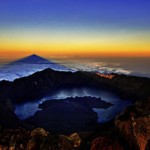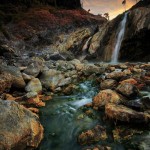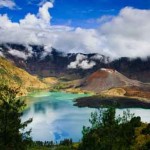
This is by far the most used route as it allows the (relatively) less strenuous trek to the crater rim only. You start at an elevation of 600 m in Senaru village, normally in the late morning or early afternoon and make the 6 hour ascent to the crater rim before dark. First part of the trek is through tropical rainforest. Look and listen out for the lutung, or black monkey, swinging through the trees in the late morning. They are extremely shy, unlike for the common macaques which may gather near rest stops waiting for scraps. The route passes through POSII at 1,500 m, breaches the treeline at 2,000 m (POSIII) and then it is a bit of slog up gravel paths to the camp site just below the crater rim at 2,600 m. There is no clear path at the last section nearing crater rim, at an incline of 45 degrees. There is a POS Extra after POS 3, but it is pretty much gone, and the remaining bits have been chopped up by porters as firewood.
If that has not sapped all of your energy you can then make a very precarious descent down to shores of the crater lake and bath in the hot waters. You need some confidence to do this as it is a steep descent of 600+ m using handrails and ropes.
And then it is back to Senaru the way you came. Local guides claim going down is faster, but speed varies for individuals. Patience is vital for first timers, as it can get frustrating watching porters sail past you with their load balanced on one shoulder, clad in slippers or even walking barefoot. Descent from POS Extra to POS 3 can be slippery when weather is dry, as scree tends to give way under your feet. From POS 3 to POS 2, the descent can take 1.5 to 2 hours, as savannah grasslands fades away, and the humidity and heat from the tropical rainforest begins to set in. Useful tip: request for guides to cut out a wooden trekking pole if you did not bring a trekking pole with you. It will be extremely handy during the descent, especially when legs are aching from the strenuous climb.
There is an option to go on to Plawangan II where you overnight again before making the ascent to the absolute summit. This is not especially recommended from the Senaru side though. If you want to get to the top, the climb to Plawangan II is best made from Sambulan Lawang.
SENARU VILLAGE ROUTE
The village of Senaru, an easy 2.5 hours drive from Mataram or Senggigi, is the main access to the National Park. As a non-trekking destination it is also popular – a cool, flower-filled mountain village stretching along a hillside spur above Bayan. Senaru has a range of accommodation in simple home stays (losmen), and a number of cafes serving delicious local specialties. The Rinjani Trek Centre at the trailhead offers displays, ecotourism activities, and visitor information. Village guides, including several local women, escort visits to the adjacent traditional village, three waterfalls, and a number of Village Walks. Circuits include the one hour Rice Terraces and Waterfall Walk, or discover the highlights of Senaru in a lovely half-day Senaru Panorama Walk.
The cool, flower-filled mountain village of Senaru on the slopes of Mt. Rinjani stretches up a hillside spur along a winding road above Bayan. It is a scenic 2.5 hours drive from Mataram or Senggigi to Senaru. The Desa includes the hamlets of Senaru, Batu Koq and Tumpang Sari, and all offer accommodation in simple but pretty homestays (losmen) with lovely views.
The Rinjani Trek Centre is located at the top of the village at the trailhead. It offers information for visitors on the Rinjani Trek, the National Park, Sasak culture and the range of ecotourism activities available for visitors to Senaru. National Park and village entry fees are paid here, and all porters for trekkers have to be hired from the Senaru Porters Group which is also based in the Rinjani Trek Centre. Village guides, including several local women, have been specially trained to escort visitors around the sights. Arrange a guided excursion through the Rinjani Trek Centre or your losmen.
Senaru Traditional Village
A visit to the Senaru Traditional Village, situated next to the Rinjani Trek Centre where the Rinjani trail begins, is greatly enhanced by asking a local guide to show you around. The Sasak inhabitants are the cultural guardians of Mount Rinjani and its surrounding forest and safeguard its spiritual values. Locally guided visits include opportunities to experience the villagers’ daily life, visit their thatched houses, prepare meals using local produce, and understand their traditional way of life.
Morning waterway walk and sunrise
Leave your losmen early for a one and a half hour escorted walk through the fields, past traditional villages and along the irrigation channel that winds through village fields past crops and houses. Enjoy visiting local homes, seeing early morning activities and learning about farming methods. Witness the sun rising from the sea beneath the spectacular sweeping views of north Lombok from the summit of Mt. Rinjani to the coast.
Evening walk and sunset
Below the Senaru Traditional Village, a one and half hour escorted walk along village trails brings you to the “secret waterfall” or “traditional swimming pool”, the Tumpasan Senaru. Enjoy a refreshing swim or late afternoon laze. On the return trip, visit some local hamlets as the people return from their fields, and enjoy the sunset over Mt. Agung in distant Bali from a vantage point in a local orchard.
Senaru panorama walk
Discover all the highlights of Senaru on an easy half-day walk through the scenic landscape of palm-fringed rice terraces, waterways, traditional village and rainforest waterfalls. Follow the irrigation channel that winds through the village fields – the lifeline of the district. Local women will guide you, happy to share their special knowledge of culture, customs and nature. This tour departs every morning from the Rinjani Trek Centre.
kampung bet
kampungbet
kampungbet
daftar slot






